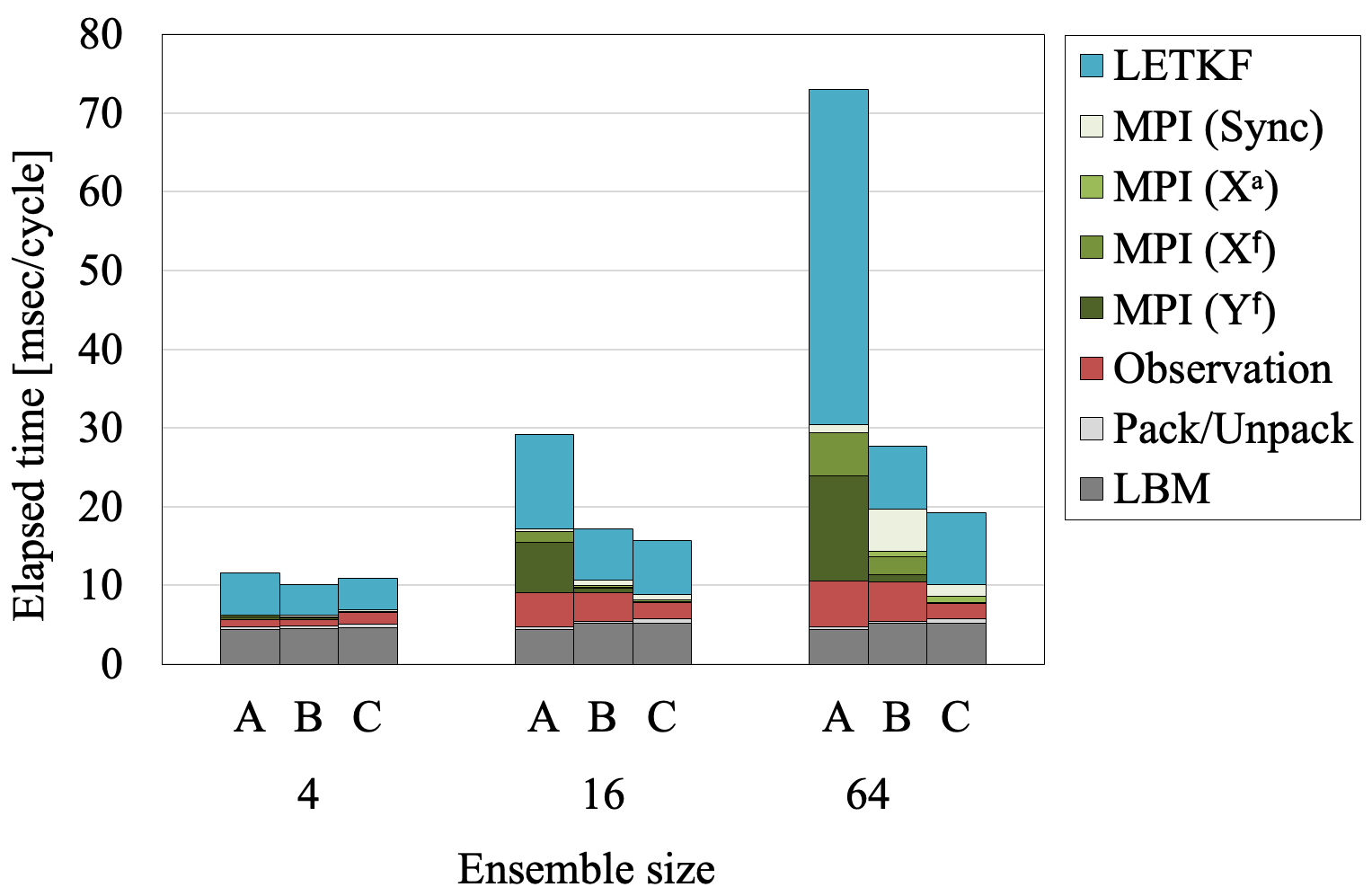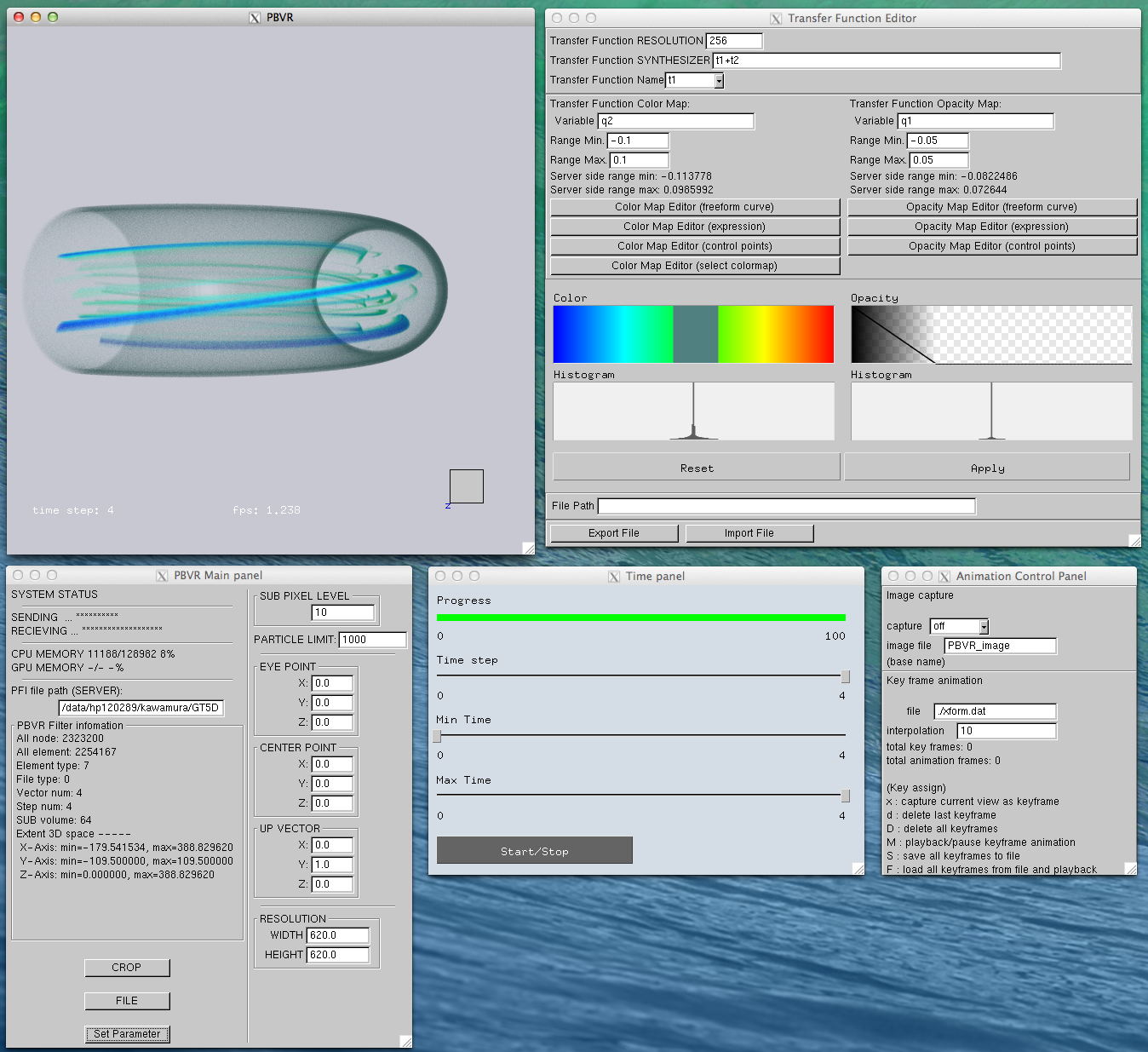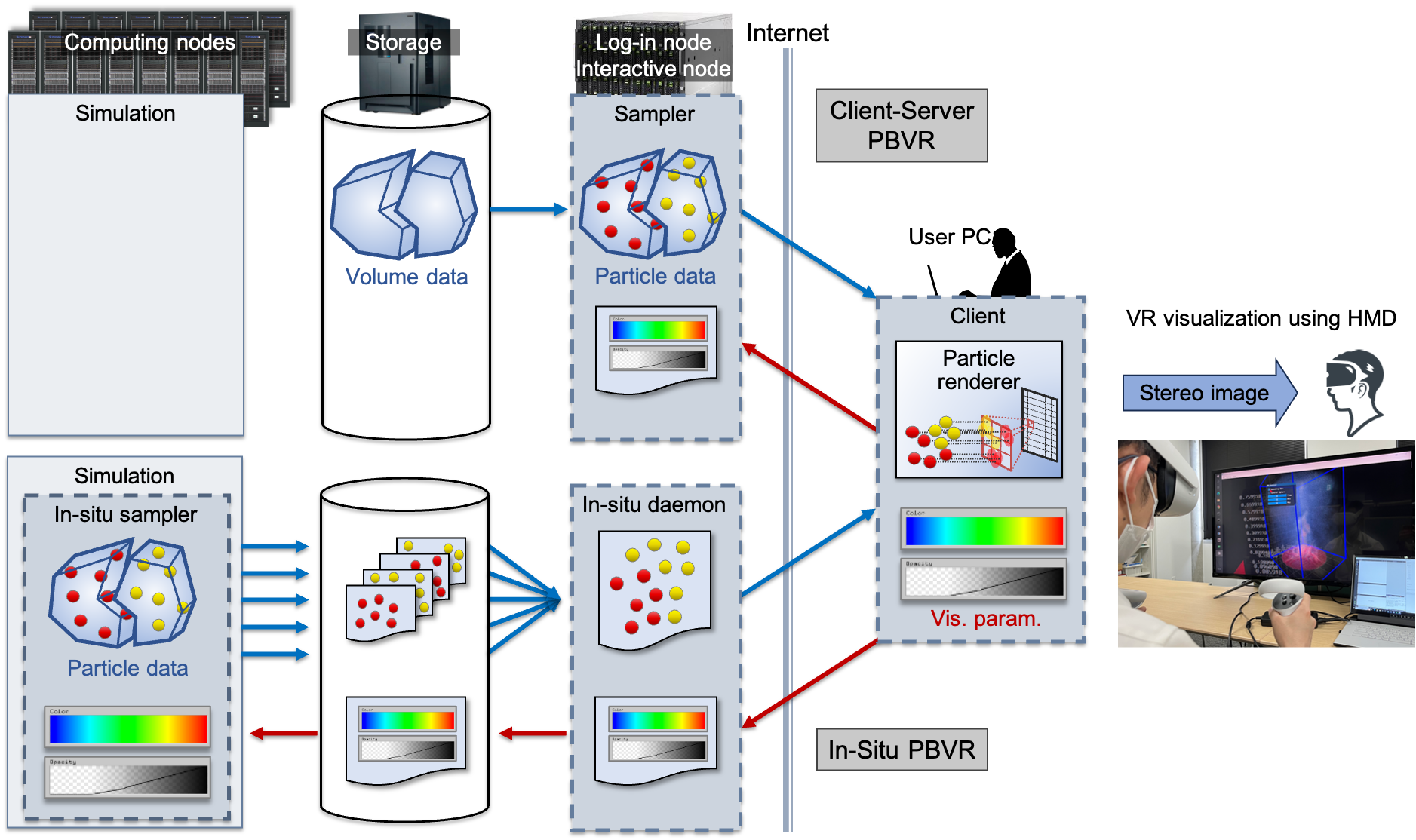HPC/DX Research and Development Office†
HPC/DX Research and Development Office promotes R&D in computer science and computational science, which support computational nuclear engineering.
| What's New†
- 1 Apr. 2024 Due to the reorganization, Computer Science Research and Development Office was renamed HPC/DX Research and Development Office
- 1 Mar.2024 Multi-point remote visualization application ML-PBVR v.1.0.0 was released.
Click here to see past updates
| Member†
- Yasuhiro Idomura (Deputy Director/General Manager, research map, google scholar)
- Naoyuki Onodera (Assistant Principal Researcher, research map)
- Takuma Kawamura (Assistant Principal Researcher, research map, ClientServer Vis. App. , In-Situ Vis. App. )
- Yuta Hasegawa (Scientist, research map)
- Kenta Sugihara (Scientist, research map)
- Yos Sitompul(Scientist, research map, google scholar)
- Takuya Ina (Chief Engineer, research map)
- Akie Mayumi (Engineer, research map)
- Kazuya Shimomura (Engineer, research map)
| Research Topics†
- High Performance Computing
- Computational Fluid Dynamics
- Data Assimilation
- Visualization
- Machine Learning
| High Performance Computing†
We develop accelerator optimization techniques and parallel computing technologies for exascale computing.
(Sparse Matrix Solver Library PARCEL: https://ccse.jaea.go.jp/software/PARCEL/index_eng.html )
Computational performances of preconditioned conjugate gradient solvers in PARCEL, PETSc, and AmgX for the three dimensional Poisson equation (768x768x768) using 32 CPUs/GPUs on the HPE SGI8600. In the benchmark, different preconditioners (Jacobi preconditioner, Block Jacobi preconditioner, Fine Block Jacobi preconditioner, Neumann series preconditioner) and data formats (CRS, DDM) are compared.
| PETSc CPU CRS Block Jacobi all-MPI | PARCEL CPU CRS Block Jacobi MPI+OpenMP | PARCEL CPU DDM Fine Block MPI+OpenMP | AmgX GPU CRS Jacobi MPI+CUDA | PARCEL GPU CRS Neumann MPI+CUDA | PARCEL GPU DDM Neumann MPI+CUDA | |
| Elapse Time [s] | 137.03 | 125.45 | 83.03 | 9.45 | 11.88 | 7.89 |
| Memory [GB] | 379 | 158 | 126 | 167 | 269 | 151 |
(Poisson solver for hundreds billion grids systems using a CG method with a communication-avoiding multigrid preconditioner)
- T.Ina, Y.Idomura, T.Imamura, N.Onodera,"A new data conversion method for mixed precision Krylov solvers with FP16/BF16 Jacobi preconditioners", HPC Asia '23: Proceedings of the International Conference on High Performance Computing in Asia-Pacific Region,2023,pp. 29-34,doi:/10.1145/3578178.3578222.
- T. Ina, Y. Idomura, T. Imamura, S. Yamashita and N. Onodera, "Iterative methods with mixed-precision preconditioning for ill-conditioned linear systems in multiphase CFD simulations," 2021 12th Workshop on Latest Advances in Scalable Algorithms for Large-Scale Systems (ScalA), 2021, pp. 1-8, doi: 10.1109/ScalA54577.2021.00006.
- Y. Idomura, T. Ina, Y. Ali and T. Imamura, "Acceleration of Fusion Plasma Turbulence Simulations using the Mixed-Precision Communication-Avoiding Krylov Method," SC20: International Conference for High Performance Computing, Networking, Storage and Analysis, 2020, pp. 1-13, doi: 10.1109/SC41405.2020.00097.
- Y. Ali, N. Onodera, Y. Idomura, T. Ina and T. Imamura, "GPU Acceleration of Communication Avoiding Chebyshev Basis Conjugate Gradient Solver for Multiphase CFD Simulations," 2019 IEEE/ACM 10th Workshop on Latest Advances in Scalable Algorithms for Large-Scale Systems (ScalA), 2019, pp. 1-8, doi: 10.1109/ScalA49573.2019.00006.
- Y. Idomura, T. Ina, S. Yamashita, N. Onodera, S. Yamada and T. Imamura, "Communication Avoiding Multigrid Preconditioned Conjugate Gradient Method for Extreme Scale Multiphase CFD Simulations," 2018 IEEE/ACM 9th Workshop on Latest Advances in Scalable Algorithms for Large-Scale Systems (scalA), 2018, pp. 17-24, doi: 10.1109/ScalA.2018.00006.
| Computational Fluid Dynamics†
We develop GPU-based exascale CFD simulations towards real-time wind and plume dispersion analyses, which are needed for the prediction of plume dispersion in nuclear accidents and the design and operation of smart cities.
・Real-time wind simulation for a 4km x 4km area in metropolitan Tokyo(movie: https://youtu.be/VD-FMbNvzhs )
・Weak scalability of the CityLBM code on GPU supercomputers
・Tracer dispersion simulation in Oklahoma City :Visualization of buildings and concentrations(Movie:https://youtu.be/dCJnx30ky6s) and Scatter plots of concentration
- N. Onodera, Y. Idomura, Y. Hasegawa et al., “Real-time tracer dispersion simulation in Oklahoma City using locally mesh-refined lattice Boltzmann method”, Boundary-Layer Meteorology, 179, 2021, pp. 187-208, doi: 10.1007/s10546-020-00594-x.
- N. Onodera, Y. Idomura, et al., “Communication Reduced Multi-time-step Algorithm for Real-Time Wind Simulation on GPU-based Supercomputers”, Proc of 2018 IEEE/ACM 9th Workshop in ScalA, 2018, pp. 9-16, doi: 10.1109/ScalA.2018.00005.
| Data Assimilation†
We develop data assimilation technique which combines simulation and observation data to improve prediction accuracy of CFD.
(Data assimilation experiment against 2D isotropic turbulence)
(GPU optimization of a data assimilation scheme (LETKF): https://github.com/hasegawa-yuta-jaea/LBM2D-LETKF )
- Y. Hasegawa, T. Imamura, T. Ina, N. Onodera, Y. Asahi and Y. Idomura, "GPU Optimization of Lattice Boltzmann Method with Local Ensemble Transform Kalman Filter," 2022 IEEE/ACM Workshop on Latest Advances in Scalable Algorithms for Large-Scale Heterogeneous Systems (ScalAH), 2022, pp. 10-17, doi: 10.1109/ScalAH56622.2022.00007.
- Y. Hasegawa, N. Onodera, Y. Asahi, T. Ina, T. Imamura, and Y. Idomura, "Continuous data assimilation of large eddy simulation by lattice Boltzmann method and local ensemble transform Kalman filter (LBM-LETKF)", Fluid Dynamics Research, 2023, vol. 55, no. 6, p. 065501, doi:10.1088/1873-7005/ad06bd.
| Visualization†
We develop large-scale parallel visualization technologies for exascale simulations and technologies for visualizing multivariable data obtained from complex simulations. We develop large-scale visualization technologies for exascale simulations using particle-based visualization (PBVR). We also develop visualization technology for multivariate data obtained from complex simulations.
・Remote Visualization Software PBVR: https://ccse.jaea.go.jp/software/PBVR/index.html
This technology visualizes large data on remote storage in a client-server fashion. Particle-based visualization technology compresses large data into small particle data for visualization (server processing) and transfers the data to user PCs for visualization (client processing), enabling interactive visualization.
・VR Remote Visualization Software VR-PBVR
Extending CS-PBVR, VR-PBVR is being developed to provide VR visualization of large data on remote storage with a head-mounted display.
・In-Situ Visualization Framework based on PBVR: https://ccse.jaea.go.jp/software/In-Situ_PBVR/
In-Situ visualization is a technology that avoids I/O bottlenecks in large-scale simulations by coupling visualization code to the simulation on a supercomputer. This framework enables interactive visualization during batch processing simulation by in-situ file base control method and PBVR.
・Multivariable Data Visualization using Algebraic Formula
For multivariate data visualization, this technology designs color and opacity functions that relate multiple physical values using user-specified algebraic expressions. This visualization gives experts an image of multivariate data.
- Takuma Kawamura, Yuta Hasegawa, Yasuhiro Idomura, "Interactive Steering on In-Situ Particle-based Volume Rendering Framework", Journal of Visualization, 2023. doi: 10.1007/s12650-023-00945-z.
- Takuma Kawamura, Naohisa Sakamoto, Tsukasa Osaki, "VR Extension of Client Server Type Particle-based Volume Visualization Application", Journal of Advanced Simulation in Science and Engineering, Vol. 10, No. 1, pp. 31-39, 2023.
- Takuma Kawamura, Yasuhiro Idomura, "Improvement of Interactive Remote In-Situ Visualization using SIMD-aware Function Parser and Asynchronous Data I/O", Journal of Visualization, Vol. 23, pp. 695–706, 2020. doi: 10.1007/s12650-020-00652-z.
- Takuma Kawamura, Tomoyuki Noda, Yasuhiro Idomura, “Performance Evaluation of Runtime Data Exploration Framework based on In-Situ Particle Based Volume Rendering”, Supercomputing Frontiers and Innovations, Vol. 4, No. 3, pp. 43-54, 2017. doi: 10.14529/jsfi170302.
- Takuma Kawamura, Yasuhiro Idomura, Hiroko Miyamura, Hiroshi Takemiya, "Algebraic design of multi-dimensional transfer function using transfer function synthesizer." Journal of Visualization, Vol. 20, pp. 151–162, 2017. doi:10.1007/s12650-016-0387-1.
| Machine Learning†
We develop a deep learning model from large scale Computational Fluid Dynamics (CFD) dataset to predict the plume concentration in the urban area under steady state flow condition.
(Plume concentration from CFD simulation (left) and the prediction by the deep learning model (right): https://github.com/yasahi-hpc/CityTransformer )
- Y. Asahi, N. Onodera, Y. Hasegawa, T. Shimokawabe, H. Shiba and Y. Idomura, "CityTransformer: A Transformer-Based Model for Contaminant Dispersion Prediction in a Realistic Urban Area.", Boundary-Layer Meteorol (2023). doi: 10.1007/s10546-022-00777-8.
- Y. Asahi, S. Hatayama, T. Shimokawabe, N. Onodera, Y. Hasegawa and Y. Idomura, "AMR-Net: Convolutional Neural Networks for Multi-resolution Steady Flow Prediction," 2nd Workshop on Artificial Intelligence and Machine Learning for Scientific Applications (AI4S), 2021, pp. 686-691, doi: 10.1109/Cluster48925.2021.00102.











